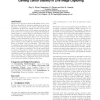Free Online Productivity Tools
i2Speak
i2Symbol
i2OCR
iTex2Img
iWeb2Print
iWeb2Shot
i2Type
iPdf2Split
iPdf2Merge
i2Bopomofo
i2Arabic
i2Style
i2Image
i2PDF
iLatex2Rtf
Sci2ools
ICARCV
2008
IEEE
2008
IEEE
Gaining colour stability in live image capturing
Digital colour cameras are dramatically falling in price, making them affordable for ubiquitous appliances in many applications. An attempt to use colour information reveals a significant problem that usually escapes our awareness. Due to the adaptive nature of the human visual system in most cases we do not recognise most changes in illumination characteristics, a camera however will measure scenes under changing illumination differently. Attempts to deduce object colour from the images will need to cope with the influence of the illumination and the camera’s characteristics. Furthermore, a large variety of colour spaces are available to describe colour. Differences between them and their fitness to quantify colour are discussed. This paper tries to establish a basic understanding of the intricacies behind the processes involved in capturing images and recognising colour—from light as a stimulus to the colour sensed values in cameras. The goal is to outline a novel approach...
| Added | 30 May 2010 |
| Updated | 30 May 2010 |
| Type | Conference |
| Year | 2008 |
| Where | ICARCV |
| Authors | Guy K. Kloss, Napoleon H. Reyes, Martin J. Johnson, Kenneth A. Hawick |
Comments (0)

